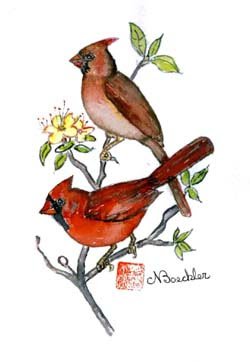One reader bought some suet and a suet-feeder from Duncraft. He heard, correctly, that birds will take some time to get used to a new feeder.
One method will speed up the process - scatter lots of food around the new feeder. Use the window sills, the ground, nearby bushes and trees. Foods include any nuts, bread products, seed, and fat. A bird watcher could also put out various kinds of fruit - raisins, grapes, oranges, apples, berries. I always take the fruit we are not going to eat and add it to the bird banquet.
An abundance of food will create a racket, attracting birds, who will remember the location as a source of nutrition and socializing, where local gossip can be exchanged. "Seen any cats lately?"
"Has Sassy ever caught anything?"
I have a large bag of oranges and some older apples. I will cut the oranges and nail them near our primary bird feeder. I may nail up apples too. I have often rolled them into the woods, content to let the raccoons find them.
Animals draw attention to food and water but they seldom make pigs of themselves. Squirrels do not eat the entire corn cob. Birds like the cedar waxwing will land in a hawthorn bush, but they only eat some of the berries at each visit.
A bird bath will be noisy with birds splashing and chirping. One way to make it even more attractive is to suspend a dripping container over it so a high-pitched dripping sound communicates to wildlife that flowing water is near. They will find it anyway, but the dripping container is often used to increase the effect.


